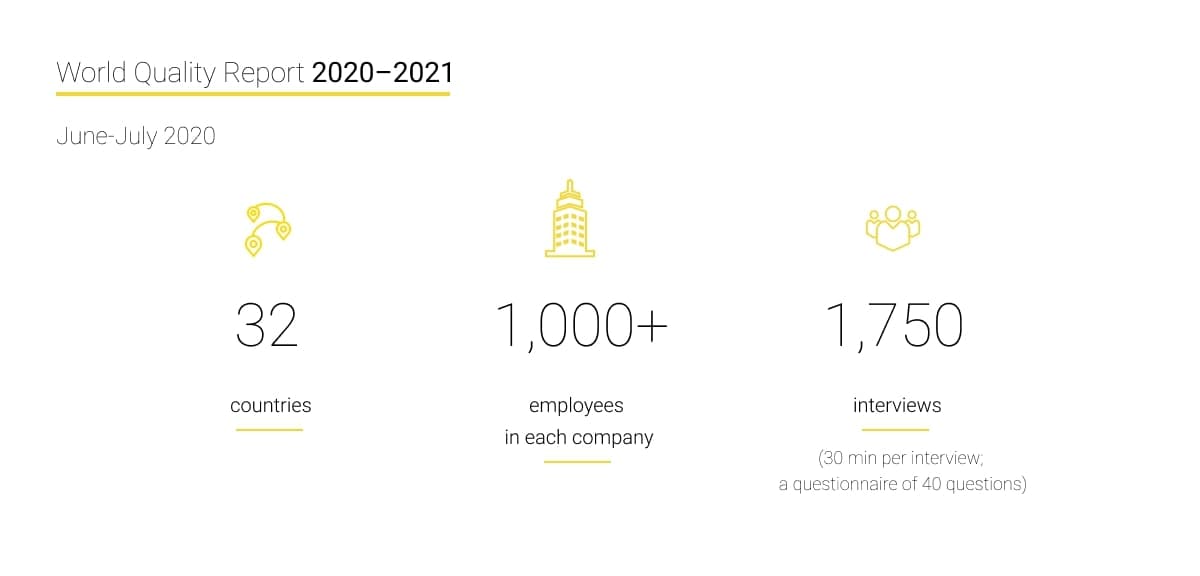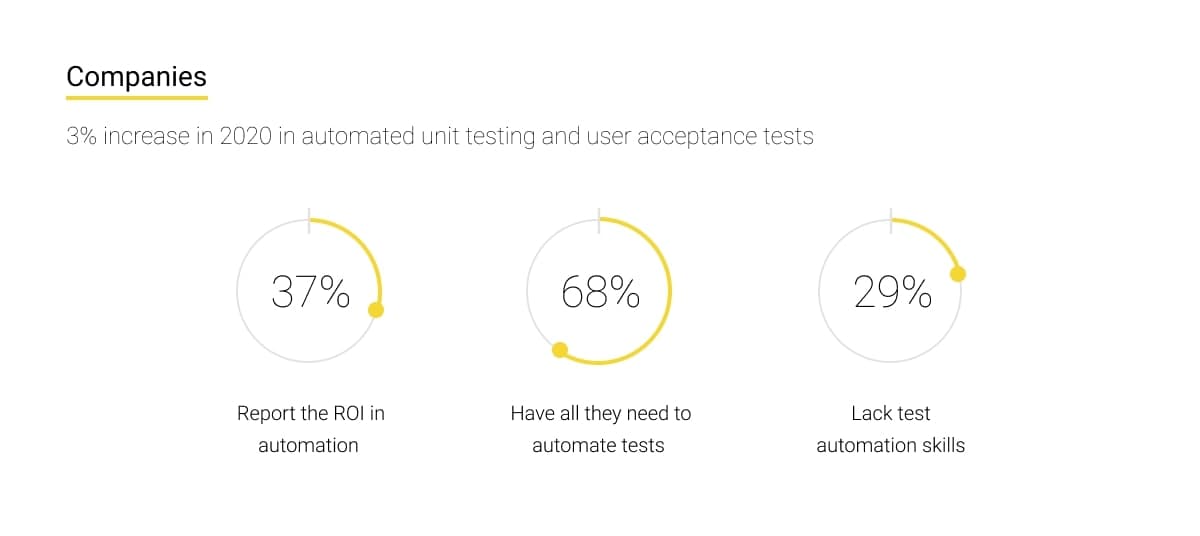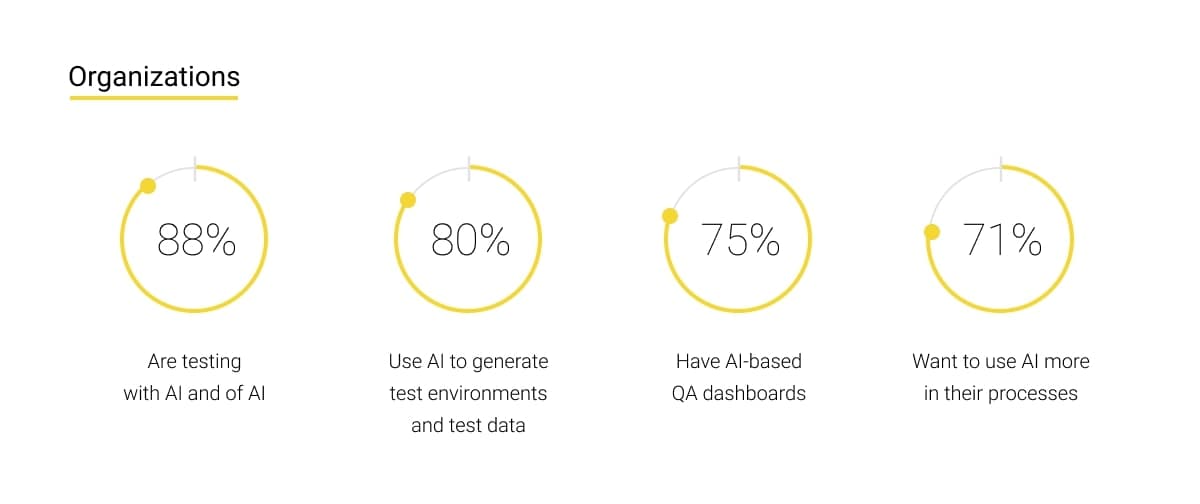- World Quality Report 2020-2021 Review and Top Software Testing Trends
- The future of testing in the IT industry
- Digital transformation
- The evolution in Agile and DevOps adoption
- Test automation trends
- AI among key software testing trends
- How to keep up with the software testing trends
- Conclusion
World Quality Report 2020-2021 Review and Top Software Testing Trends
The future of testing in the IT industry
The World Quality Report 2020-2021 is a comprehensive review of the current situation in QA worldwide and its future trends. More than 1,750 interviews were taken during the survey. The organizations shared their experience on the challenges they faced over the past year. The document also reflects the top software testing trends of the present day and the foreseeable future.
 The World Quality Report 2019-2020 stated that the mission of QA was the continued improvement of business results. What has changed since that time? How did the upheavals experienced by the companies determine the perspectives of QA? And what is the software testing latest news? Read the article below to find the answers.
The World Quality Report 2019-2020 stated that the mission of QA was the continued improvement of business results. What has changed since that time? How did the upheavals experienced by the companies determine the perspectives of QA? And what is the software testing latest news? Read the article below to find the answers.

Digital transformation
The current non-typical world situation has forced drastic changes in all business processes that would have taken much longer otherwise. QA, as well as other areas of IT, have been actively adopting digital strategies. The remote nature of business has become commonplace over the past months, and it requires digital support. That means the entire IT sector and QA in particular need to adjust to the new reality and thus to come up with breakthrough solutions. Moreover, companies are innovating in order to stay competitive in the context of decreased investments in software testing.
The evolution in Agile and DevOps adoption
The number of organizations implementing Agile and DevOps models in their processes is growing slowly but steadily. The release of new apps is on the rise. That means the testing should start earlier in the development lifecycle and be carried out more often to ensure high product quality. More than half of the respondents said they sought to test as early as possible. At the same time, 40% of the survey participants reported that the process made up one-third of their entire work on the product. The level of mastering the above methods depends, among other things, on the business location. The US is way ahead of Europe in this regard.
Although these approaches help companies deliver products to the market more frequently, difficulties in their implementation remain. Specifically, 42% of organizations admitted their Agile experts were not skilled enough in testing. However, the teams can address these challenges by testing earlier in the development, leveraging automation tools, and introducing quality dashboards.
Test automation trends
The advantages of automation are evident. It allows QA engineers to manage their job more effectively, have better visibility of processes, and reduce the time dedicated to testing. However, such a technology is still expensive, and only one-third of the companies report the ROI from this tool. To make it more affordable, the organizations should more actively use AI in testing and build self-maintaining tests where the scripts are modified automatically.
Since last year, there has been a 3% increase in the number of organizations automating their unit testing and user acceptance tests. Among the most frequent constraints on the adoption of this technology is the lack of test automation skills, which was named by 29% of the research participants. Another common issue is that the tests can't keep up with the frequent changes to apps and fall behind. However, the overall automation rate continues to increase. In particular, 68% of the respondents say they have everything needed to apply this technology to their processes.

AI among key software testing trends
Experts had a wide-ranging discussion of the role of AI in testing in the previous World Quality Report. Today it’s the center of attention again. 88% of organizations state that they turn to AI when testing. Predictive analytics and Machine Learning help 80% of QA teams in creating test environments and test data. Three-fourths of the survey participants reported they used AI-based QA dashboards in their work.
However, 71% of the respondents admitted they would like to see an increase in the implementation of AI-driven tools into their testing processes. One-fourth of the companies reported that their teams don’t have the sufficient skills to leverage AI techniques. Therefore, organizations should promote a culture that focuses on test automation.

How to keep up with the software testing trends
Here are a few tips on how companies can prepare for the future now. We recommend that they take the following steps that align with the above-mentioned observations:
- To bridge the gap between the developers and the testers by giving quality the dominant place across the entire organization.
- To build more automated tests using smarter testing frameworks, AI-driven tools, and removing the skill gaps of your QA team.
- To get ready for force-majeure circumstances by drawing up a well-designed disaster plan and a business continuity plan.
- To manage test environments and test data with the help of AI-based techniques, establishing a center of excellence.
Conclusion
The global situation has made substantial alterations to the course of development of the QA industry. The events of recent months sped up the digitalization in software testing and forced organizations to introduce smarter tools into their workflows. However, to build a complete picture of the latest QA trends, we encourage our readers to turn to the full version of the World Quality Report 2020-2021.













